Writing
"Supersonic" was written and recorded in a single day at the Pink Museum Studio in Liverpool, [1] on 19 December 1993. [4] It was produced by Oasis with their live sound engineer,Mark Coyle. [5] Guitarist Noel Gallagher claimed he wrote the song in half an hour, [1] [6] [nb 1] while his studio colleagues were taking a break from recording to eat a Chinese takeaway. [9] [10] Rather than joining them,Noel remained in the studio backroom working on his guitar riff and finished writing before they returned. [9] [10] Guitarist Paul "Bonehead" Arthurs recalled:
Noel's just sat there with the guitar and he just wrote the music, that will do, and then he wrote the words, any old fucking words and he came back in the room with us, with his guitar and he said, 'Look, I've just written another song.' He started singing it and we nailed it and mixed it that night, rapid, because that's what we'd been doing every night in the Boardwalk, you know, and it sounded massive, absolutely massive. [10]
According to Noel, "Supersonic" was the only Oasis single written in the studio after another song, "Bring It on Down", was discarded. Although Noel is credited as the sole songwriter, he revealed in the 2004 documentary of Definitely Maybe that Bonehead and bassist Paul "Guigsy" McGuigan assisted him in writing the chords. [1]
Additionally, drummer Tony McCarroll wrote in his 2010 book The Truth: "Now, I know that Noel is the main songwriter for Oasis, but there were many instances like this where the band as a whole – and The Real People too – were integral to the composition of a song." [nb 2] McCarroll also recounted that Noel did not want to credit brothers Chris and Tony Griffiths of the Real People as co-producers of "Supersonic" or feature the band itself as a guest act on any future Oasis performance, leading to a verbal altercation between Noel and singer Liam Gallagher as well as constant problems with the rest of the band members.
Recording
Following a short local tour with the Verve, Oasis performed at the Krazy House club in Liverpool, supporting the Real People, on 16 December 1993. After the gig, they booked sessions at the Pink Museum with Coyle and engineer Dave Scott for a few days, [nb 3] funded by £300 per day, to record "Bring It on Down" for release as their then-upcoming debut single, at the request of Creation Records owner Alan McGee. [1] [9] However, according to Noel, the intended song recording was abandoned due to a disagreement over McCarroll's drumming. [1] [9] He said: "It would become apparent that session didn't work because our drummer at the time wasn't the most consistent from one fucking bar to the next, never mind one day to the next." [9]
According to Scott, Oasis attempted to record a studio version for "I Will Believe", but he dismissed the result because it sounded like an early 1980s indie pop song. [17] Scott later described the unreleased version as a "shoe-gazer shit." [19] Instead, after unsuccessful attempts to record "I Will Believe", [19] Noel wrote a new song, "Take Me Away", in less than five minutes, and recorded it acoustically in 15 minutes. [17] Noel played an Epiphone acoustic guitar with a half-pint glass, creating a slide guitar sound that Coyle overdubbed through a Roland Space Echo before Scott mixing the track in another five minutes. [19]
On the last day of the sessions after recording "Take Me Away", Oasis began jamming together, [17] attempting to work on an instrumental they had played as a warm-up during the session of "Bring It on Down" and which would become "Supersonic". [22] The jam session began with McCarroll playing a "lazy" drumbeat, which was quickly followed by Bonehead playing rhythm guitar and Liam rattling his tambourine over the beat. Noel soon joined them and played a guitar melody over the rhythm. Meanwhile, Scott asked the Griffiths brothers, who were present at the sessions, to give Oasis musical and technical advice. [17] [19] Instead of recording B-side songs, Tony Griffiths suggested them to develop their jam as it has the potential of a hit single. [24]
After Tony's suggestion, Noel went to the corner and quickly wrote down the lyrics, and then Oasis began recording "Supersonic". To record the song, Scott had to remove a take of "I Will Believe" because he did not have a spare tape. [19] Bonehead used a Gibson SG guitar owned by Scott and a Marshall JCM900 amplifier owned by Chris Griffiths. [19] Noel played an Epiphone Les Paul guitar through a Watkins Dominator MKIII combo amp. [25] For Noel's lead guitar, Scott added additional overdubs by placing the amp in the studio's stone room with close-and-distance microphones and slightly speeding up the tape to thicken the guitar tone over the track. [19] [25] Scott removed McCarroll's hi-hats [nb 4] to record tambourine and handclaps tracks. [19]
After recording the backing tracks, [19] Liam recorded his vocals in one single take, with Noel guiding him [nb 5] and Scott using a Lexicon PCM70 reverb and TC-2290 delay on the vocals. [19] Tony contributed five layers of backing vocals to the song, [19] influenced by the Beatles' backing vocal style. According to Scott, "Supersonic" was recorded and mixed in 11 hours, [19] while Noel said it took eight hours to be completed. [28] [nb 6] Although it was originally based as a demo, it was never re-recorded, and this refers to producer Owen Morris, who later reworked on some other tracks on Definitely Maybe prior to its release. [1] After the recording was finished, the song was introduced to McGee as a potential alternate single; he was impressed. [1] According to tour DJ Phil Smith, "Supersonic" alone cost £100 to produce. [30]
Composition
Music
"Supersonic" has been classified as a rock, [32] Britpop, [25] [33] hard rock, [33] and alternative rock song, [34] with elements of neo-psychedelia and American grunge music. [35] [36] It contains Blur-like vocals, [37] "brief but smashing" guitar riffs and "catchy melodic" chorus. [36] Along with the Definitely Maybe song "Live Forever", the basic rock rhythm of "Supersonic" is reminiscent of early 1970s music. [38] The song's cascading guitars are influenced by the Sex Pistols' 1977 song "Pretty Vacant", and also draw influences from bands such as the Who, the Rolling Stones, the Beatles, and the Stone Roses.
The song is played in the key of F♯ minor in a 4
4 time signature with a tempo of 104 beats per minute (BPM), [40] while Liam's vocals span a range of E4 to F♯5. [41] The chord progression follows a sequence of F♯m11–Asus2–B7. As with "Bring It on Down", the power chord sequence of "Supersonic" is heavily influenced by Nirvana's Nevermind (1991); [nb 7] according to author Alex Niven, Noel adapted Kurt Cobain's guitar technique (specifically in the Nevermind hits "Smells Like Teen Spirit" and "Come as You Are") by adding phaser effects for his overdubbed lead guitar to produce a "swirling, underwater" guitar sound.
"Supersonic" begins with a simple drumbeat played by McCarroll, followed by an arpeggiated guitar riff played by Noel. [44] During the intro, Noel produces a pick scrape guitar effect; Scott suggested this technique after being dissatisfied with McCarroll's drum intro. [19] According to Scott, he wanted it to sound like the intro to Peter Gabriel's 1980 song "Intruder", but Noel ended up producing a sound that was "slightly different and quicker." [19] Noel's guitar solo has a striking resemblance to the opening riff of "My Sweet Lord" (1970) by George Harrison, with a slightly different guitar harmony. [45] However, Noel has denied deliberately copying it. [24]
Lyrics
I describe it as the "I Am The Walrus" of the '90s. If you listen to "I Am The Walrus," [it's] a big '60s psychedelic mind-fuck of a single. If you listen to "Supersonic," it's round about the same, but it's in 1994 as opposed to 1967. It's a rock song with off-the-wall lyrics. I've written songs that I didn't know what they meant when I was writing them and have become apparent because they've been about a subject in the first place. [28]
— Noel Gallagher on "Supersonic"
The lyrics are often regarded as a distillation of "lumpen" nonsense poetry, with "forced" doggerel rhymes and "half-baked" allusions in multiple lines throughout the song, such as "I'm feeling supersonic / Give me gin and tonic", [47] "He lives under a waterfall / Nobody can ever hear him call", [48] "I know a girl called Elsa / She's into Alka-Seltzer", [47] "And she makes me laugh / I got her autograph", [49] "She done it with a doctor, on a helicopter" and "She's sniffing in a tissue, selling the Big Issue ". [48]
The lyrics are "simplistic" and exhort self-confidence, [36] particularly in the opening lines: "I need to be myself / I can't be no-one else". [50] Arun Starkey of Far Out described "Supersonic" as "a triumphant call to arms for those wanting self-determination." [51] Like the Definitely Maybe song "Cigarettes & Alcohol", "Supersonic" has an alcoholism-themed lyric: "Give me gin and tonic"; [52] this line was written after Scott passed Noel a gin and tonic drink for stimulation instead of whiskey or beer, which were giving Noel a headache. [19] The song mentions various vehicles, including cars, submarines, [53] trains and helicopters. [48] It also saw the band's first lyrical nod to their idols, the Beatles: "You can sail with me in my yellow submarine", [24] referring to their 1966 song "Yellow Submarine" or their 1968 film of the same name. [54]
Most of the lyrics were inspired by the few days Noel experienced while Oasis were in Liverpool. [17] For example, the line "Can I ride with you in your BMW?" was inspired by Tony Griffiths' car spotted by Noel. [1] According to Noel, the main inspiration for writing "Supersonic" came from Scott's then nine-year-old Rottweiler dog, Elsa, [24] who was suffering from flatulence and hiding under the mixing desk while the band were working in the studio, [1] hence the lyric "I know a girl called Elsa / She's into Alka-Seltzer". [17] Despite this, even after Noel revealed Elsa's identity, some Oasis fan girls with the same name claimed that the song was inspired by them. [56] Some commentators interpreted the song to be about prostitution, [24] [28] but Noel also denied this, explaining: "It's usually lyricists that will tell you that the words are fucking everything. They are not, the words don't mean shit to anybody. It's the melody is what you remember. We all whistle tunes; it's always about the melody, and that's what I do." [10]
"Supersonic" was released as a single in Ireland on 5 April 1994, in the UK on 11 April, by Creation, and in the US on 11 September, by Epic Records. It was included as the sixth track on Oasis' debut album Definitely Maybe, released on 29 August 1994. Upon its release, the single received extensive airplay on several independent radio stations in England, as well as late-night shows on BBC Radio 1. It peaked at number 31 on the UK Singles Chart on the week of 23 April 1994, [61] and stayed there for 60 weeks, half of which came following the commercial success of the band's second album, (What's the Story) Morning Glory? (1995). [63] However, "Supersonic" remained the band's lowest-peaking single until 2015, when "Half the World Away" debuted at number 56. [64]
"Supersonic" debuted on the UK Independent Singles Chart at number three on 30 April 1994, behind "Always" by Erasure and "The Most Beautiful Girl in the World" by Prince, respectively. [65] The song was included on the compilation Indie Top 20: Vol. 20, released in the UK on 28 October 1994 on the label Beechwood Music and sponsored by Melody Maker . [66] A year later, on 1 July 1995, it re-entered and peaked the chart at number two, behind "A Girl Like You" by Edwyn Collins. [67] The CD release of "Supersonic" was included on Oasis' box sets Definitely Maybe Singles (1996) and Complete Single Collection '94–'05 (2006). [68] [69]
"Supersonic" was Oasis' first single to chart in the US; [8] [24] it debuted on the Billboard Modern Rock Tracks chart at number 33 on the issue dated 1 October 1994, [70] and peaked at number 11 on 10 December, [71] staying on the chart for a total of 16 weeks until 14 January 1995, at number 32. [72] By the end of October 1994, "Supersonic" was played 215 times in total on 38 different American radio stations, [73] and it would become the most-played track on the WENZ Cleveland radio station two months later. [74] It also reached number 38 on the Billboard Album Rock Tracks chart on the issue dated 24 December 1994. [75]
"Supersonic" reached number 92 on the European Hot 100 Singles chart on 30 April 1994. [76] It also charted in other countries including Ireland (24), [77] Scotland (35), [78] France (33), [79] New Zealand (28), [80] and Australia (122). [81] In Japan, a CD extended play (EP), Supersonic, was released by Epic Records Japan on 14 July 1994, [82] reaching number 81 on the Oricon Albums Chart. [83] By February 1995, it had sold 25,000 copies following airplay on J-Wave's Pioneer Tokio Hot 100. [84]
"Supersonic" was reissued in the UK in 2000 through Big Brother Recordings. [85] The song was included on Oasis' greatest hits albums, Stop the Clocks (2006) and Time Flies... 1994–2009 (2010). [86] [87] On 19 April 2014, "Supersonic" was reissued as a remastered 12-inch single by Big Brother, as part of the 2014 Record Store Day. [88] As of October 2016, "Supersonic" had sold over 240,000 copies, making it the band's 14th biggest-selling single in the UK, [89] even outselling their 2002 number one single "The Hindu Times", and their 2005 number one hits "Lyla" and "The Importance of Being Idle". [64]
On 12 April 2024, "Supersonic" was reissued on CD, as well as a limited edition, numbered and pearl-colored 7-inch vinyl to mark the 30th anniversary of its release. [90]
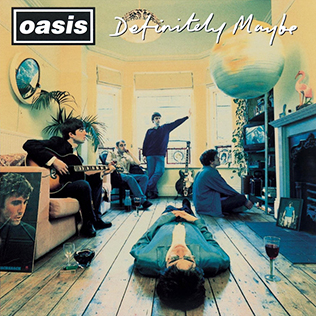
Definitely Maybe is the debut studio album by the English rock band Oasis, released by Creation Records on 29 August 1994. The album features Noel Gallagher on lead guitar, backing vocals and as chief songwriter, Liam Gallagher on lead vocals, Paul "Bonehead" Arthurs on rhythm guitar, Paul "Guigsy" McGuigan on bass guitar and Tony McCaroll on drums.

Oasis were an English rock band formed in Manchester in 1991. Originally known as the Rain, the group initially consisted of Liam Gallagher, Paul Arthurs (guitar), Paul McGuigan and Tony McCarroll (drums), with Liam's older brother Noel Gallagher joining as a fifth member a few months after their formation. Noel became the de facto leader of the group and took over the songwriting duties for the band's first four albums. They are characterised as one of the defining groups of the Britpop genre.
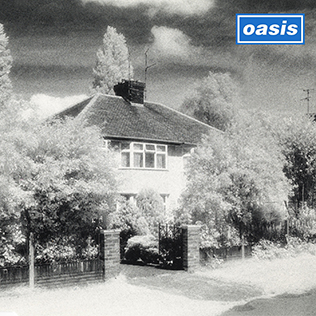
"Live Forever" is a song by English rock band Oasis. Written by Noel Gallagher, the song was released as the third single from their debut album Definitely Maybe (1994) on 8 August 1994, just prior to that album's release. Gallagher wrote the song in 1991, before he joined Oasis.
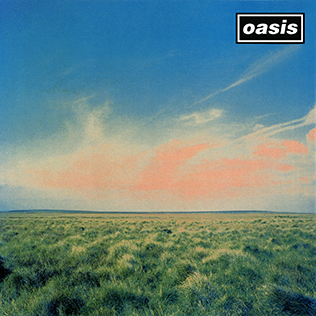
"Whatever" is a song by the English rock band Oasis. Written by the band's lead guitarist, Noel Gallagher, it was released on 18 December 1994 by Creation as the band's first non-album single. A subsequent lawsuit awarded a co-writing credit to Neil Innes.

"Cigarettes & Alcohol" is a song by English rock band Oasis, written by Noel Gallagher. It was released on 10 October 1994 as the fourth and final single from their debut album Definitely Maybe (1994), and their second to enter the UK top ten in the United Kingdom, peaking at number 7, eventually spending 79 weeks on the charts. On 13 March 2020, nearly 26 years after its release, the song was certified Platinum, indicating 600,000 sales.

"Lyla" is a song by the English rock band Oasis. It was released in May 2005 as the first single from their sixth studio album, Don't Believe the Truth (2005). "Lyla" was the band's first single following the departure of their long-time drummer Alan White, and replaced by Ringo Starr's son and the Who drummer Zak Starkey as an additional drummer of the band.

"Some Might Say" is a song by the English rock band Oasis. It was released as the first single on 24 April 1995 by Creation from their second studio album, (What's the Story) Morning Glory? (1995). The song was written by the band's lead guitarist Noel Gallagher. "Some Might Say" provided Oasis with their first number one on the UK Singles Chart and reached the top 10 in Finland, Iceland, Ireland and Sweden. The song is also the last to feature all five original members, as the drummer Tony McCarroll was fired shortly after the song's release.

"Roll with It" is a song by English rock band Oasis, written by lead guitarist Noel Gallagher. It was released on 14 August 1995 by Creation as the second single from their second studio album, (What's the Story) Morning Glory? (1995). In a highly publicised chart battle with Blur's single "Country House" dubbed "The Battle of Britpop," "Roll with It" reached number two on the UK singles chart.

"Songbird" is a song by English rock band Oasis from their fifth studio album, Heathen Chemistry (2002), and is the first single by Oasis written by vocalist Liam Gallagher. Released on 3 February 2003, the song reached number three on the UK Singles Chart, number two on the Canadian Singles Chart, and the top 10 in Ireland and Italy. During an interview with The Matt Morgan Podcast, Liam's brother and bandmate Noel Gallagher called the track a "perfect" song.

"Don't Go Away" is a song by English rock band Oasis from their third album, Be Here Now (1997). Written by Noel Gallagher, the song was released as a commercial single only in Japan, peaking at number 48 on the Oricon chart, and as a promotional single in the United States and Canada. The track reached number 35 on the US Billboard Hot 100 Airplay chart and number 15 on the Canadian RPM 100 Hit Tracks chart in late 1997.

"D'You Know What I Mean?" is a song by English rock band Oasis. Written by Noel Gallagher, it was released on 7 July 1997 as the first single from their third album, Be Here Now (1997).
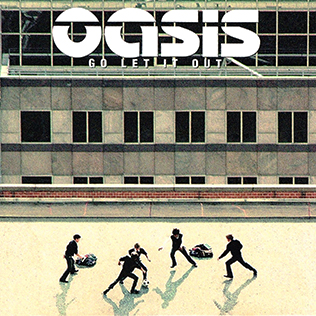
"Go Let It Out" is a song by English rock band Oasis, written by the band's lead guitarist, and chief songwriter, Noel Gallagher. It was released on 7 February 2000 as the first single from their fourth studio album, Standing on the Shoulder of Giants (2000), as well as their first following the departure of rhythm guitarist Bonehead and bassist Guigsy. The song peaked at number one on the UK Singles Chart and was later certified Gold for sales and streams exceeding 400,000. It also reached number one in Ireland, Italy, and Spain, as well as on the Canadian Singles Chart.

"Little by Little" is a song by English rock band Oasis, first released as the sixth track on their fifth studio album, Heathen Chemistry. In September 2002, it was released with "She Is Love" as the first double A-side single by the band, peaking at number two on the UK Singles Chart and number nine on the Irish Singles Chart. "Little by Little" by itself reached number two on the Canadian Singles Chart and number five in Italy. Noel Gallagher provides lead vocals on both tracks, which he also wrote.
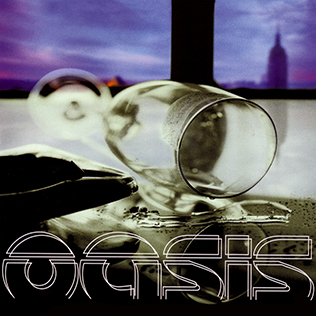
"Sunday Morning Call" is a song by the English rock band Oasis, released as the third and final single from their fourth studio album, Standing on the Shoulder of Giants. It reached number four on the UK Singles Chart, number five in Italy, and number 20 in Ireland.
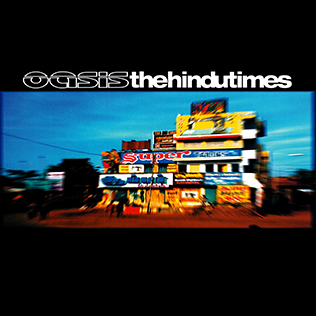
"The Hindu Times" is a song by English rock band Oasis. It was written by the band's lead guitarist Noel Gallagher, and was released as the lead single from their fifth studio album, Heathen Chemistry, on 15 April 2002. On the album, it segues directly into the next track, "Force of Nature."

"All Around the World" is a song by the English rock band Oasis. It was written by the band's lead guitarist and principal songwriter Noel Gallagher. Released on 12 January 1998 as the third single from their third studio album, Be Here Now (1997), it is the longest song ever recorded by Oasis. The song peaked at number one on the UK Singles Chart, becoming the longest song ever to reach number one, and earned a Gold certification. This was the last Oasis single to be released on the Creation Records label. The song also reached number one in Ireland and peaked at number 15 on the US Billboard Modern Rock Tracks chart.

"Let There Be Love" is a song by English rock band Oasis from their sixth studio album, Don't Believe the Truth (2005). Written by Noel Gallagher, it is the third and the last Oasis song to feature Liam and Noel on lead vocals, the first being "Acquiesce" and the second being "Put Yer Money Where Yer Mouth Is". It was released on 28 November 2005 as the third and final single from the album in the United Kingdom and as the second single in the United States.

"The Importance of Being Idle" is a song by English rock band Oasis. It was released on 22 August 2005 in the UK as the second single from their sixth studio album, Don't Believe the Truth (2005), written, produced, and sung by lead guitarist Noel Gallagher. The song was written by Gallagher in the mid-2004, before the band made their final attempt at recording what would become Don't Believe the Truth.

The discography of the English rock band Oasis consists of seven studio albums, two live albums, five compilation albums, six video albums, one extended play, twenty seven singles which includes one double single, nineteen promotional singles and thirty-six music videos. As of 2024 the band have sold 75 million records worldwide, and been cited by Guinness World Records as the most successful act in the United Kingdom between the years 1995 and 2005. Oasis had 22 consecutive UK top 10 hits between 1994 and 2008. Oasis was formed in 1991 by vocalist Liam Gallagher, guitarist Paul "Bonehead" Arthurs, bassist Paul "Guigsy" McGuigan and drummer Tony McCarroll – they were later joined by guitarist and songwriter Noel Gallagher. The band signed to Creation Records in May 1993 and released their debut single "Supersonic" the following year; it peaked at number 31 in the United Kingdom. Follow-up singles "Shakermaker" and "Live Forever" became UK top 15 hits, with the latter also attaining success in the United States. Definitely Maybe, the band's debut studio album, topped the UK Albums Chart and went on to be certified eight times platinum by the British Phonographic Industry (BPI).
"Columbia" is a song by English rock band Oasis. The song features on their 1994 debut album, Definitely Maybe.



















